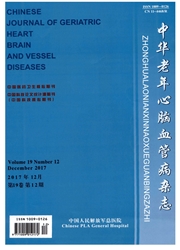

 中文摘要:
中文摘要:
目的研究局灶性脑缺血再灌注大鼠缺氧诱导因子1α(HIF—1α)表达的时序特征及丹酚酸B的调节效应。方法选择雄性Wistar大鼠54只,随机分为假手术组6只,模型组(6、24、48、72h,每时间点6只),丹酚酸B组(6、24、48、72h,每时间点6只)。制作大鼠脑中动脉闭塞模型,在不同时间点进行神经行为学评分,Western blot法检测脑组织HIF1α表达并进行比较。结果与模型组比较,丹酚酸B组太鼠在6、24、48h评分差值明显升高(P〈0.05,P〈0.01)。模型组6h时HIF1α蛋白表达明显升高,24h出现降低趋势,48h开始再次升高,并持续至72h。与模型组比较,丹酚酸B组24hHIF-15表达明显降低,72hHIF1α表达明显升高,差异有统计学意义(P〈0.01)。结论局灶性脑缺血再灌注大鼠脑组织中HIF-1α蛋白表达具有2个时相。丹酚酸B可明显改善模型大鼠的神经行为缺损症状,具有神经保护作用,其对HIF-1α蛋白表达的调节方式为时序性双向调节,即减低第一时相蛋白表达和增高第二时相蛋白表达。
 英文摘要:
英文摘要:
Objective To study the time sequence feaures of salvianolic acid B-regulated expression of hypoxia inducing factor l a(HlF-la) in rats following focal cerebral ischemia reperfusion. Methods Fifty-four healthy male Wistar rats were randomly divided into sham operation group(n=6) and model group(which was further divided into 6 h group, 24 h group, 48 h group, and 72 h group,6 in each group) ,and salvianolic acid B group(which was further divided into 6 h group,24 h group,48 h group, and 72 h group, 6 in each group). A rat cerebral middle artery occlusion model was established. Neurological behavior defect was scored and expression of HIF-1α in rat brain tissue was detected at different time points by Western blot. Results The neurological behavior defect scores were significantly higher in salvianolic acid B group than in model group at 6, 24 and 48 h(P〈0. 05, P〈0. 01). The expression level of HIF-1α increased significantly in model group at 6 h,tended to decrease at 24 h,and increased again from 48 h to 72 h. The expression level of HIF-1αwas significantly lower at 24 h and significantly higher at 72 h in salvianolic acid B group than in model group(P〈0.01). Conclusion The expression of HIF-1α protein in rat brain tissue following focal cerebral ischemia reperfusion is characterized by two time phases. Salvianolic acid B can significantly improve the nerrological behavior defect symptoms in rat model and protect nerves against injury. Salvianolic acid B regulates the expression of HIF-1α by down-regulating the first time phase and up-regulating the second time phase.
 同期刊论文项目
同期刊论文项目
 同项目期刊论文
同项目期刊论文
 期刊信息
期刊信息
